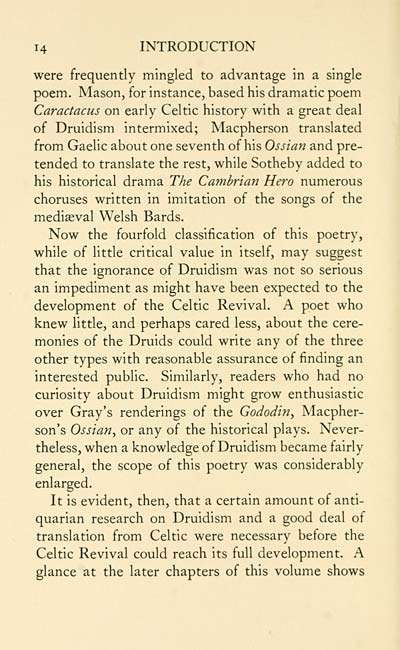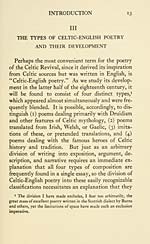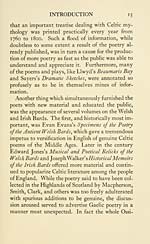Download files
Complete book:
Individual page:
Thumbnail gallery: Grid view | List view

14 INTRODUCTION
were frequently mingled to advantage in a single
poem. Mason, for instance, based his dramatic poem
Caractacus on early Celtic history with a great deal
of Druidism intermixed; Macpherson translated
from Gaelic about one seventh of his Ossian and pre-
tended to translate the rest, while Sotheby added to
his historical drama The Cambrian Hero numerous
choruses written in imitation of the songs of the
mediaeval Welsh Bards.
Now the fourfold classification of this poetry,
while of little critical value in itself, may suggest
that the ignorance of Druidism was not so serious
an impediment as might have been expected to the
development of the Celtic Revival. A poet who
knew little, and perhaps cared less, about the cere-
monies of the Druids could write any of the three
other types with reasonable assurance of finding an
interested public. Similarly, readers who had no
curiosity about Druidism might grow enthusiastic
over Gray's renderings of the Gododin, Macpher-
son's Ossian, or any of the historical plays. Never-
theless, when a knowledge of Druidism became fairly
general, the scope of this poetry was considerably
enlarged.
It is evident, then, that a certain amount of anti-
quarian research on Druidism and a good deal of
translation from Celtic were necessary before the
Celtic Revival could reach its full development. A
glance at the later chapters of this volume shows
were frequently mingled to advantage in a single
poem. Mason, for instance, based his dramatic poem
Caractacus on early Celtic history with a great deal
of Druidism intermixed; Macpherson translated
from Gaelic about one seventh of his Ossian and pre-
tended to translate the rest, while Sotheby added to
his historical drama The Cambrian Hero numerous
choruses written in imitation of the songs of the
mediaeval Welsh Bards.
Now the fourfold classification of this poetry,
while of little critical value in itself, may suggest
that the ignorance of Druidism was not so serious
an impediment as might have been expected to the
development of the Celtic Revival. A poet who
knew little, and perhaps cared less, about the cere-
monies of the Druids could write any of the three
other types with reasonable assurance of finding an
interested public. Similarly, readers who had no
curiosity about Druidism might grow enthusiastic
over Gray's renderings of the Gododin, Macpher-
son's Ossian, or any of the historical plays. Never-
theless, when a knowledge of Druidism became fairly
general, the scope of this poetry was considerably
enlarged.
It is evident, then, that a certain amount of anti-
quarian research on Druidism and a good deal of
translation from Celtic were necessary before the
Celtic Revival could reach its full development. A
glance at the later chapters of this volume shows
Set display mode to: Large image | Transcription
Images and transcriptions on this page, including medium image downloads, may be used under the Creative Commons Attribution 4.0 International Licence unless otherwise stated. ![]()
| Early Gaelic Book Collections > Ossian Collection > Celtic revival in English literature > (32) |
|---|
| Permanent URL | https://digital.nls.uk/78489150 |
|---|
| Description | Selected books from the Ossian Collection of 327 volumes, originally assembled by J. Norman Methven of Perth. Different editions and translations of James MacPherson's epic poem 'Ossian', some with a map of the 'Kingdom of Connor'. Also secondary material relating to Ossianic poetry and the Ossian controversy. |
|---|
| Description | Selected items from five 'Special and Named Printed Collections'. Includes books in Gaelic and other Celtic languages, works about the Gaels, their languages, literature, culture and history. |
|---|

